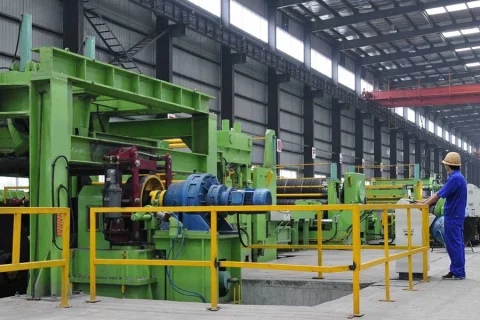Products

Pickling Line
Pickling is a metal surface treatment used to remove impurities, such as stains, inorganic contaminants, rust or scale from ferrous metals, copper, precious metals and aluminum alloys. A solution called pickle liquor, which contains strong acids, is used to remove the surface impurities. It is commonly used to descale or clean steel in various steelmaking processes.
Once the hot-band coil leaves the hot mill it goes through a series of value-added processing steps. The first of which is pickling which involves unwinding the steel and running it through a series of hydrochloric acid tanks and rinse tanks.
The primary acid used is hydrochloric acid, although sulfuric acid was previously more common. Hydrochloric acid is more expensive than sulfuric acid, but it pickles much faster while minimizing base metal loss. The speed is a requirement for integration in automatic steel mills that run production at high speed; speeds as high as 800 ft/min (≈243 metres/min) have been reported.
Carbon steels, with an alloy content less than or equal to 6%, are often pickled in hydrochloric or sulfuric acid. Steels with an alloy content greater than 6% must be pickled in two steps and other acids are used, such as phosphoric, nitric and hydrofluoric acid. Rust- and acid-resistant chromium-nickel steels are pickled in a bath of hydrochloric and nitric acid. Most copper alloys are pickled in dilute sulfuric acid, but brass is pickled in concentrated sulfuric and nitric acid mixed with sodium chloride and soot.
Sheet steel that undergoes acid pickling will oxidize (rust) when exposed to atmospheric conditions of moderately high humidity. For this reason, a thin film of oil or similar waterproof coating is applied to create a barrier to moisture in the air. This oil film must later be removed for many fabrication, plating or painting processes.
Pickled steel can be sold directly into the market or sent to the cold mill for further processing.
End use applications for pickled and oiled steel include: automotive frames; electrical cabinets; stampings, and painted unexposed structural parts.
BONO works directly with the client to determine the specifics regarding their needs. Rest assured, we have the right product to meet the solutions you require. New, big or small, a quick consultation will allow us to find the right fit!
Related Products















